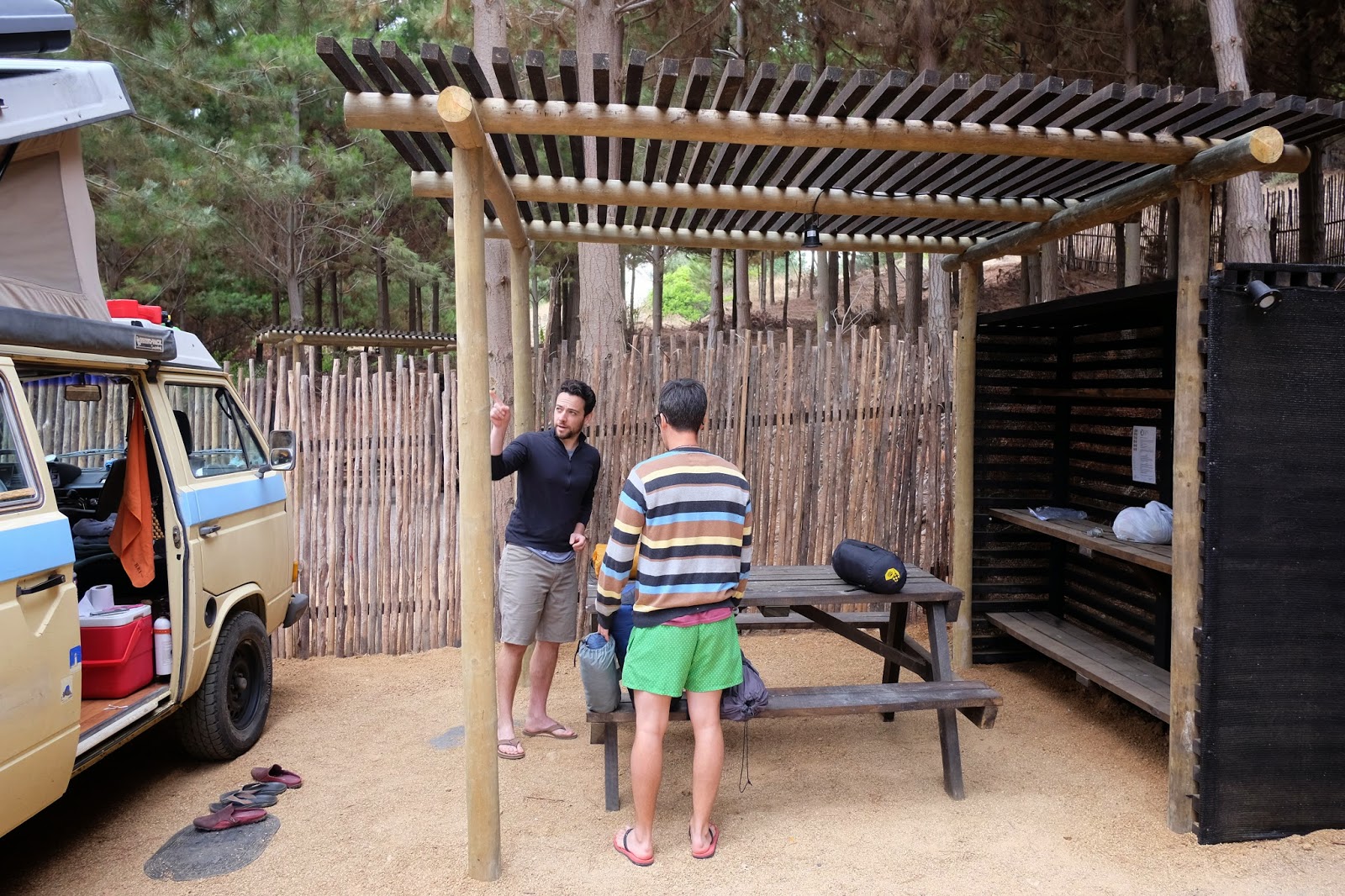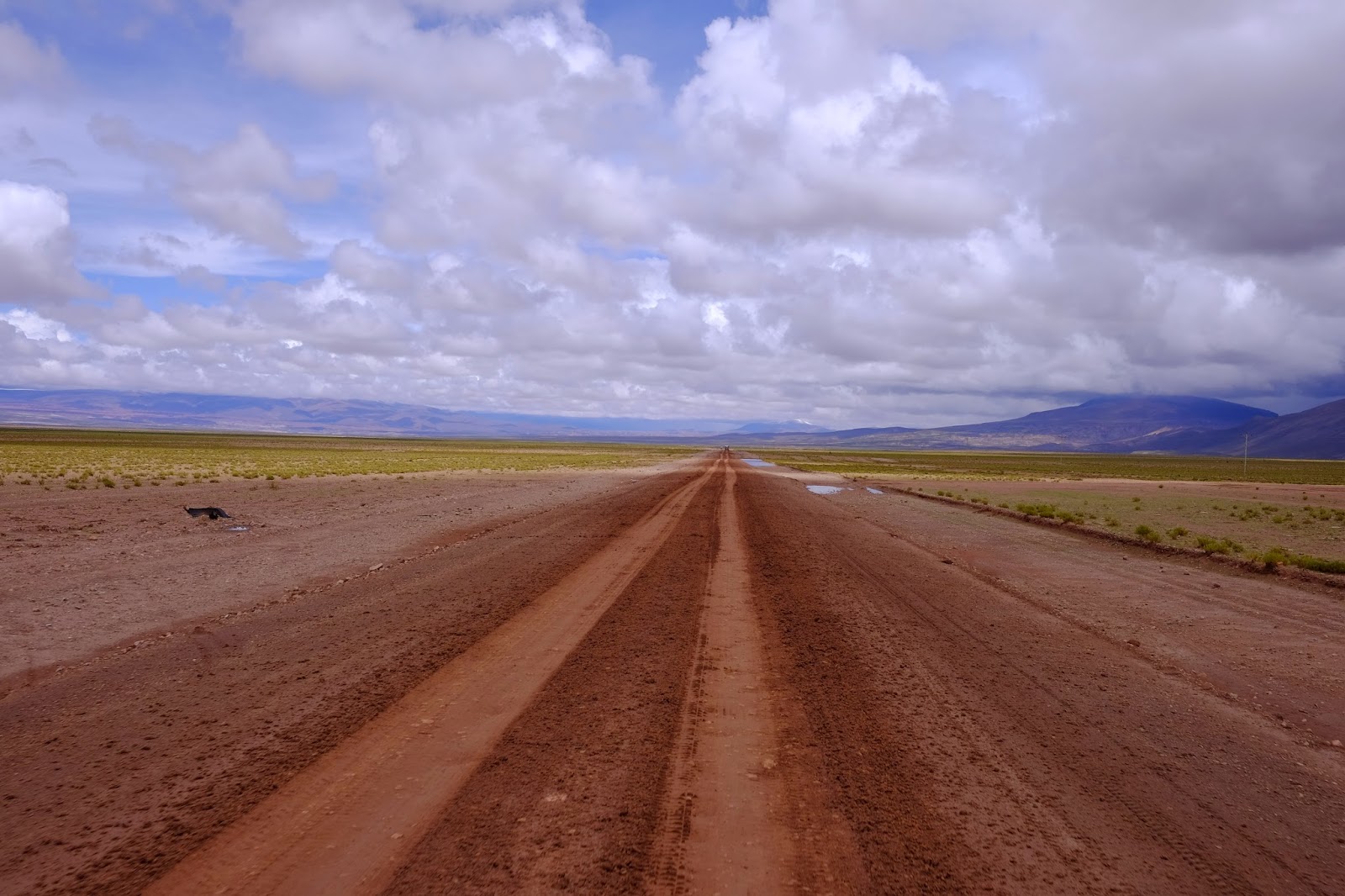Day 1: We drive from Arica, Chile to Oruro, Bolivia. The border crossing is beautiful and quick – snow capped volcanoes, flamingo filled lakes and all at about 15k feet. That night we stayed next to yet another flamingo filled lake, with a beautiful sunset, stunning stars and the place to ourselves.
Day 2: We drive from Oruro to Uyuni on a road that is under construction. We get lost in every town that the detours run through. We knew about the road construction ahead of time, but it was the fastest route to the Salar de Uyuni. We enjoyed some fantastic pizza and slept parked on the street for the first time since Leon, Nicaragua, which you may remember from
here.

Day 3: We know there’s a chance that there may be too much water to take Dolores to the Salt Flats, but we decide that it’s worth a try. When we arrive at the entrance, we know right away that there is no way we can take our house through the Salt Flats turned giant lake ahead. In places the water is 5 feet deep and almost everywhere else there’s about 4 inches of standing saltwater. The water creates a beautiful reflection of the clouds and the sky so we hang out for a bit take a few pictures and head back to town for lunch. We eat lunch at a small local kitchen near the market and halfway through my meal I break into a sweat and think that I’m going to vomit or pass out at the table. I keep it together long enough to finish the meal and make it back to the van to lie down. George decides it’s time to put Uyuni in the review mirror so we start to motor south. On the way out of town we stop to fill up on gas. In Bolivia, as a foreigner, you have to negotiate for your gas. Yeah, it sounds pretty odd and it is. It goes like this, the Bolivian government has decided that Bolivians pay 3 Bolivianos per liter (about $.50) and extranjeros pay 8.865 (about $1.20) Bolivianos per liter, so about $4.80 per gallon. What this amounts to is that many of the gas station attendants are willing to make a little money and give you a rate somewhere between the extranjero and the local rate. So George negotiates our rate to 7 Bolivianos. We fill up, only 7 liters (just topping off the tank before the big drive south). We pay the attendant and thank him and start to drive away. He laughs and says in Spanish, “What’s the problem, have you never bought gas in Bolivia?”
At first we’re confused, what does he need/mean? Yes, we’ve bought gas in Bolivia, but what are you talking about?
After a few more exchanges and him threatening to call the police (by this time a small crowd had gathered around), we understand that he doesn’t remember us paying. He’s asking for our full payment again.
But Senor, we just paid you. That 50 in your pocket is ours. Nope, not a chance.
In the end we’re forced to pay again. In total we paid 100 Bolivianos for 7 liters of gas, about 14 Bolivianos per liter, or $8 per gallon (almost double the extranjero rate). Not a crazy amount of money, and only enough gas to top off, but is was still an uncomfortable situation.
I think his forgetfulness was genuine; George is not so naïve. Regardless, we both promptly decide we have to get to Chile where we can afford to by gas again. After a bumpy and rainy drive that night we find ourselves camped out on the Altiplano and fall asleep to the sound of the rain.
Day 4: We wake up to a gray morning, but the rain has stopped. The large road sized puddles and water crossings are numerous. Occasionally we are reminded that we’re surrounded by huge mountains, because we can see the bases covered in snow, but the peaks stay hidden in the clouds. We make our way further south into the National Park, and when were about 6 miles from Laguna Colorado, one of the park’s crown jewels, we reach a hill at 4300M that Dolores won’t climb.
We try everything, I drive George pushes, George drives I push, running starts, zig-zags, reverse and then it starts to rain and any additional plans or ingenious ideas that we would have had are destroyed. We wait to see if we can convince another car to tow us up the last 25 feet, but no one comes. The park is supposed to be our exit of Bolivia and entrance back into Chile so we run through our options.
A) On the map we see that there is an entrance on the east side of the park and we think we have enough gas to make it around and then out of the south of the park.
B) There is a border crossing slightly northwest of where we are, Ollague, but we’ve heard that road is terrible and even 4x4’s have trouble. And we’re not sure we have enough gas to make it.
C) Set the van on fire.
We go for option A and start truckin’. The rain has actually made the roads smoother and before we know it’s time to find a place to stay for the night. We pull off the road and realize that for 360 degrees there is not a single sign of human life except for the road and our van.
Day 5: In the morning the sun is shining, the few days of rain have made the roads a little more comfortable to travel except for the places it’s been washed out. We arrive at the park entrance sooner than expected. As we talk with the ranger we understand the road is good the rest of the way and the two rivers that we have to cross are low right now. We pay our entrance fee to the park, 300 Bolivianos, and make our way further south. We’re so excited that everything is coming together!
About 4 miles from the ranger station, we come to the first river crossing. It’s almost double our comfort level for deep water, putting too many things in danger on our beloved Dolores. After exploring all options up and down the banks, we go over our new options:
A) There is a border crossing slightly northwest of where we are, Ollague, but we’ve heard that road is terrible and even 4x4’s have trouble. Now we absolutely don’t have enough gas to make it.
B) Return to San Cristobal and get gas and figure out our next move from there.
C) Set the van on fire.
We go with option B. On our way out of the park we chat with the ranger, he assures us that the road to Ollague is good, but that there is nowhere to get gas for about 300 miles. He does however have 30 liters that he’s willing to sell us for 7 Bolivianos per liter. Perfect, but it’s not enough gas to get us all the way to Ollague. Interestingly enough, we planned to have a bit of extra money when we left Bolivia, (just-in-case fund) and after this purchase we had exactly 100 Bolivianos, not enough to purchase the extra gas we would need to make it to the border crossing and then to the next town in Chile that had gas. Since we had to drive right past the hill that had thwarted us the day before, we decided that we would give it another try. The whole way there we stoked Dolores out, promised her a new paint job, makeover, the whole shebang. When we got there we both looked at each other, convinced that this hill was ours! We weren’t going to be beaten!! As the motor sputtered to stop at the same place we’d marked with a rock the day before we couldn’t believe our luck. In the distance we saw 6 land cruisers approaching. We pulled out our towrope and awaited their arrival. The 6th and final one that refused to make eye contact with us and didn’t stop made my heart sink.
At some point during our drive, maybe it was the altitude (14k feet) or the luck we’d been having, we found ourselves thinking about the pizza that we had in Uyuni that was so good. It might have been after I broke my window crank, thankfully we had one in our spare parts bag so the next time we stopped I quickly replaced it. We weighed the rangers advice about the road to Ollague, (keep in mind he’s the same guy who told us we could cross a really deep river with no problem) and in the end we decided to drive all the way back to Uyuni for pizza. Once our decision was made, George drove at neck breaking speeds over terribly washboarded roads. We stopped only to take in the stunning views – the clouds had cleared and we could see all of the huge mountains surrounding us. We pulled into town, almost deaf from the sound of our house rattling behind us for hours. When we pulled up to the pizza place, it was closed- the owner gone on vacation. Town was crazy with carnival so we needed a secure place to park. We checked the only hostel we knew of in town with parking. She told us they were full, but after a little checking she made us fit. As I rolled up the window as we settled into our parking spot for the night, the window crank broke off in my hand. Two broken window cranks in one day, must have been some kind of record of the perfect ending to the perfect day.



Day 6: Since we were back in Uyuni, it seemed like a good idea to book a tour to the Salt Flats. It was a great day full of sun, fun people, funny photos and someone else to drive us around all day in a vehicle that George wouldn’t have to fix. Oh yeah, Rachel got to drive the landcruiser around the Salar while we jammed out to music and rode on the roof of the car. Fiesta.
Day 7: We depart early in the morning and start our roughly 1000 mile backtrack to Arica. With the uncertainty of how the van is running we opt for the paved route via Potosi. That night we sleep at a gas station.
Day 8: We crossed the border into Chile and made it to Arica in time for dinner and head straight to bed.








































